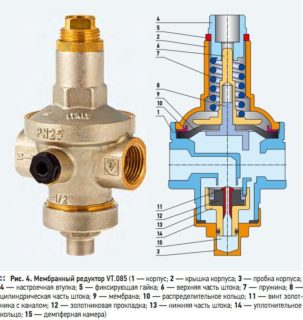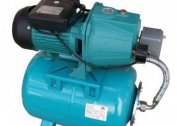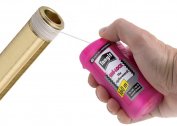Instructions for use of plumbing fixtures contain data on the parameters of the modes under which the devices will function for a long time. However, pressure surges affect the integrity of thermostats, faucets, boilers, and other bathroom and kitchen equipment. A pressure regulator built into the system is able to level the spasmodic change in water pressure.
Definition and purpose of the pressure reducer in the water supply system
Water hammer in the backbone network appears when it is started incorrectly, causing jumps in the recharge parameters.
Pressure regulators are designed to protect the water supply system from a sharp change in the parameters of the working environment and equipment damage caused by them. In other words, the purpose of the water supply reducer is to control and reduce the pressure, if the nominal value is reached. For this, a diaphragm or piston is used, with which the supply of water is limited.
Gearboxes can have different throughputs. Productivity of household regulators is usually 3 m3 / h, commercial appliances have higher technical specifications - up to 15 m3 / h. More powerful devices are used in production with an indicator of more than 15 m3 / hour.
For reliability, the device enclosures are made of the following materials:
- brass;
- stainless steel;
- bronze.
The plating can be chrome or nickel. There are reducers for domestic hot water and cold water. One of the types of connection is used during installation of the device: flange or threaded.
Principle of operation
Fluid parameters are optimized using a sensitive membrane. At normal values, the spring-loaded diaphragm is at rest. An increase in pressure implies a change in resistance, which causes the sensitive device to move away and transmit a pulse to the surface of the valve or piston.
Water hammer causes a multiple increase in pressure, since water does not compress. When the membrane acts, the piston moves in the enclosed space of the housing, so the device instantly responds to the slightest changes in parameters and prevents damage from water hammer, limiting the flow of water. Thus, the pressure reducer protects the water supply network and the devices installed in it from rapid changes in the hydraulic mode, which adversely affect all plumbing devices, causing them to break.
It is incorrect to install the pressure regulator after the meter, since the measuring device will remain defenseless before changing the hydraulic mode. If you look at the pressure gauges that are installed in the heat point, you can see that the arrows are constantly swaying, indicating the dynamics of the parameter.
Types and device
- piston - have the simplest design;
- membrane;
- flowing.
The steel case is equipped with two nozzles having an internal thread. Some models come with a tube for a pressure gauge and a screw for adjustment.
The gearbox, in which the valve is made in the form of a diaphragm, is a reliable device. It does not require manual configuration. The capacity of the membrane regulator is up to 3 m3 / hour. The valve divides the chamber into 2 parts. In the hermetic compartment, there is a spring behind it, which, having received an impulse from the elastic lobe, is compressed, driving the valve that closes the hole.At the same time, the flow of water decreases and the pressure in the system decreases.
If the parameter decreases, the spring is straightened and the valve opens the passage wider, the water flow increases.
A spring-loaded piston regulates the pressure in the network with the help of a built-in valve, which during rotation changes the inlet opening, compressing or releasing the spring. The simplicity of the device and low cost makes it popular with consumers. In order to prevent the device from breaking down quickly, they must install a water filter at the entrance, which is sometimes included in the package.
Durable and reliable flow-type pressure regulators. They have no moving elements. The design includes a labyrinth with holes, due to which the flow rate decreases, as it is divided into separate jets. Such devices are used at network pressures up to 3 atm.
Key selection criteria
 When buying a regulator, they look at the design features, case material, technical specifications. Too cheap lightweight gearboxes will not last long, as they can be made of low-quality alloys that cannot withstand changes in the parameters of the water environment.
When buying a regulator, they look at the design features, case material, technical specifications. Too cheap lightweight gearboxes will not last long, as they can be made of low-quality alloys that cannot withstand changes in the parameters of the water environment.
If you choose among piston and diaphragm devices, the former are considered less reliable. This is due to the high sensitivity of the device to water quality: ingress of particles of sludge leads to jamming of the piston lock. Another reason lies in the vulnerability of elements to corrosion.
Membrane regulators are unpretentious in operation and reliable, but their weak point is the integrity of the diaphragm. Pistons practically do not give in to attrition.
To choose a reducer according to the nominal pressure, which can be from 4 to 6 atm, you need to focus on the technical instructions of home plumbing devices. Another important indicator is temperature. If an operating range of up to 40 degrees is indicated, the gearbox is designed for operation in a cold water supply system; for domestic hot water, this parameter is 130 degrees.
Mounting Features
The gearbox can be installed independently if the user knows how to do such work. You will need an adjustable wrench, a fum tape or another seal, two ball shut-off valves and the gearbox itself.
For convenience, choose a horizontal section. First, the water supply is shut off, then an inlet valve, a filter, a gearbox and a ball type valve are installed. To prevent leaks, all connections are sealed with tow.
The next step is to adjust the water pressure reducer in the apartment's water supply system according to the algorithm:
- close the outlet tap;
- open water;
- fix the nominal pressure in the pipeline, usually it is maintained at 3 atm;
- use the key to set the arrow to the indicated value.
Automatic gearboxes do not require manual tuning.
Operation and maintenance
Housing and utilities establish pressure regulators, which are designed for high-rise buildings, to supply water to the upper floors, so excess pressure on the lower floors is always associated with the risk of fistulas.
Device maintenance is reduced to monitoring the pressure in the network. Damage to the membrane due to corrosion of the rod and spring will not allow you to adjust the output parameters. Leakage due to wear on the gaskets also indicates the need for repair. All elements can be easily purchased in the distribution network and repair the gearbox.






